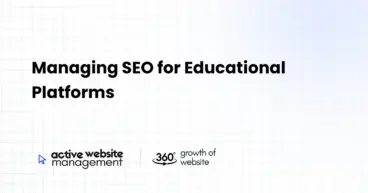January 3, 2025
8 min read
Website accessibility and SEO (Search Engine Optimization) are two crucial aspects of modern web development that go hand in hand. Both contribute to providing a better experience for users while ensuring your website ranks higher in search engine results. In this article, we’ll dive deep into the importance of improving website accessibility and how it can positively impact your SEO efforts. We’ll also discuss best practices, tools, and the role of Active Website Management in maintaining and improving your site’s accessibility.
1. What is Website Accessibility?
Website accessibility refers to the design and development practices that ensure websites are usable by all people, including those with disabilities. The primary aim of accessibility is to make content available to a broader audience, including individuals with visual, auditory, cognitive, and motor impairments.
A website with good accessibility practices allows users to navigate, interact, and understand the content on the site regardless of their abilities or disabilities. Accessibility features include things like screen readers, high-contrast text, keyboard navigation, and more. These features are essential for providing an equitable user experience for everyone.
2. The Connection Between Website Accessibility and SEO
Website accessibility and SEO are deeply interconnected, even though they are often considered separate aspects of web development. Google and other search engines prioritize providing the best user experience. Websites that are accessible are more likely to provide a better experience for users, which in turn leads to higher search engine rankings.
When websites are accessible, they are also easier for search engines to crawl and index. Accessibility features such as semantic HTML elements, proper use of headings, and image alt text help search engines understand your content better, improving both user experience and SEO performance.
Why Accessibility Matters for SEO
- Improved Crawlability: Accessible websites with clear navigation and structured data are easier for search engine bots to crawl. This can improve the site’s ranking in search engine results.
- Higher Engagement: Accessible websites provide a better user experience, leading to lower bounce rates and higher time-on-site, both of which are positive ranking factors.
- Broader Audience Reach: Websites that are accessible reach a wider audience, including individuals with disabilities. A larger audience translates to more potential visitors and higher chances of conversion.
Don’t Just Maintain Your Website—
Grow It using Active Website Management! Don't Wait for Growth—Accelerate It with Active Website Management
3. Benefits of Improved Website Accessibility
By improving the accessibility of your website, you are not only complying with legal requirements (in some regions), but you also benefit from a range of advantages that enhance both user experience and SEO:
- Better User Experience: An accessible website ensures that all users can interact with your site, including those with visual, hearing, or cognitive disabilities.
- Increased Organic Traffic: As accessibility features contribute to better SEO, your website is more likely to rank higher in search engines, attracting more visitors organically.
- Legal Compliance: In some countries, businesses are required by law to make their websites accessible. Failing to do so could result in lawsuits and fines.
- Positive Brand Image: Demonstrating a commitment to inclusivity can improve your reputation among users and clients, enhancing trust and loyalty.
- Mobile Friendliness: Many accessibility practices overlap with mobile optimization, helping you provide a seamless experience across all devices, which is important for SEO.
- Enhanced Search Engine Crawling: Search engines like Google prioritize accessible websites because they tend to have clean code and proper structure. This improves your website’s visibility and indexability.
- Increased User Engagement: Accessible websites often result in better engagement rates, such as longer time on site and lower bounce rates. These factors contribute to improved rankings.
- Higher Conversion Rates: Websites that are easier to navigate and understand are more likely to convert visitors into customers. This impacts your bottom line and SEO indirectly.
- Better Structured Data: Websites that follow accessibility standards often use proper HTML semantics (like headings, lists, and links), which makes it easier for search engines to understand the content.
5. Best Practices for Improving Website Accessibility
Improving website accessibility involves several strategies. Here are some key best practices that can help you enhance accessibility while also boosting your SEO performance:
5.1 Use of Alt Text for Images
Images are an important part of any website, but they must be described in ways that make sense to users who rely on screen readers. Alt text provides a textual description of images, helping users with visual impairments understand the content.
SEO Tip: Alt text should be descriptive and include relevant keywords when appropriate. However, it’s essential not to overstuff keywords—focus on clarity and relevance.
Read more about SEO for eCommerce websites
5.2 Ensure Proper Heading Structure
Headings (H1, H2, H3, etc.) help both users and search engines understand the hierarchy and structure of your content. A logical heading structure aids navigation and readability.
SEO Tip: Use only one H1 per page, which should represent the main topic. Follow a hierarchy with H2s for subheadings and H3s for further divisions. This structure improves both accessibility and SEO.
5.3 Keyboard Navigation and Focus
Ensure that users can navigate your website using only a keyboard. This is crucial for users with motor disabilities. Implementing clear focus indicators is also important for accessibility.
SEO Tip: Proper keyboard navigation and focus indicators enhance the user experience, reduce bounce rates, and contribute to better rankings.
Forms are a vital part of many websites, but they can be a barrier to accessibility if not designed correctly. Ensure all form fields are labeled clearly and that form validation is accessible.
SEO Tip: Accessible forms increase conversion rates, which signals to search engines that your site is user-friendly, ultimately boosting your SEO.
5.5 Text Readability and Color Contrast
Ensure that your website text is easy to read, especially for those with visual impairments. Use high-contrast colors and legible font sizes to improve readability.
SEO Tip: Clear text and good color contrast help keep visitors on your site longer and reduce bounce rates, which can help improve SEO performance.
5.6 Making Your Website Mobile-Friendly
Mobile responsiveness is another critical aspect of accessibility. A mobile-friendly website adapts to various screen sizes, ensuring a smooth user experience.
SEO Tip: Google uses mobile-first indexing, meaning that mobile-friendly websites are prioritized in search rankings. Improving mobile accessibility is key for both user experience and SEO.
Don't Wait for Growth—Accelerate It with
Active Website Management Don't Wait for Growth—Accelerate It with Active Website Management
Several tools can help you identify accessibility issues and improve your site’s compliance. Here are some popular ones:
6.1 Google Lighthouse
Google Lighthouse is a free tool that audits your website for performance, accessibility, SEO, and more. It provides detailed reports on how to improve your site’s accessibility.
6.2 WAVE
WAVE (Web Accessibility Evaluation Tool) is an easy-to-use tool that provides visual feedback about the accessibility of web content. It helps identify errors such as missing alt text, broken links, and more.
6.3 axe Accessibility Checker
axe is a popular accessibility testing tool that integrates with browsers like Chrome and Firefox. It helps identify accessibility issues in real-time, making it easy for developers to fix them as they work.
7. How Active Website Management Helps Improve Accessibility
Active Website Management (AWM) is an essential service for businesses looking to maintain an accessible, optimized website. With AWM, you don’t have to worry about manually implementing accessibility fixes or missing important updates. Some key ways AWM supports accessibility improvements include:
- Proactive Website Updates: AWM regularly implements accessibility improvements to ensure your website is up-to-date with the latest standards and best practices.
- SEO & Performance Optimization: AWM ensures that your website is optimized for both accessibility and SEO, helping it rank better while being accessible to all users.
- Monthly Reports and Strategy: AWM provides detailed reports on accessibility and performance, allowing you to track improvements and refine your strategies.
By integrating accessibility practices into your ongoing website management, you can ensure continuous growth and improved user engagement, making your site both inclusive and high-performing.
8. Conclusion
Improving website accessibility is not only essential for providing a better user experience but also for enhancing your SEO performance. By following best practices, using the right tools, and incorporating accessibility into your ongoing website management, you can ensure your website is inclusive, optimized, and positioned to rank higher in search engines.
If you’re looking to take your website’s accessibility to the next level, consider investing in Active Website Management. With proactive support and continuous updates, AWM helps ensure your site remains accessible, optimized, and primed for success.






